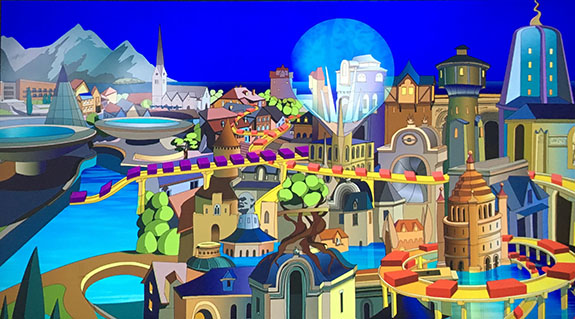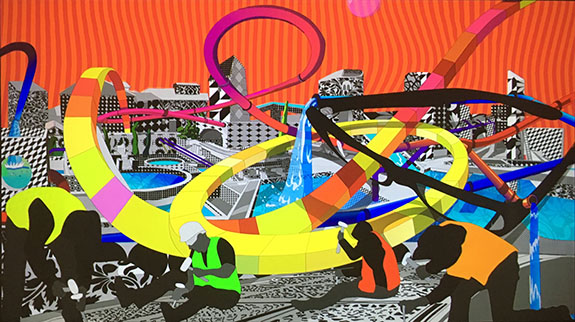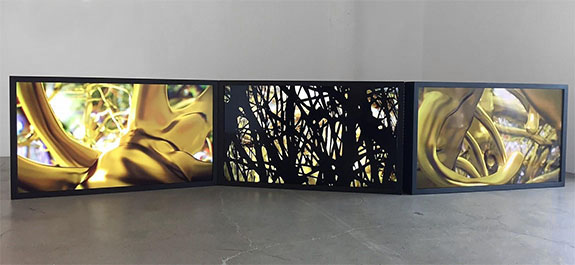
by David M. Roth
Is it the dawn of the apocalypse or the birth of a new civilization? That is the unanswered question hovering around Chris Doyle’s dazzling new digital animation, Swell, the final installment of his five-part series based on Hudson River School founder Thomas Cole’s The Course of Empire (1833-36), a cycle of paintings that portrayed the evolution and dissolution of ancient Rome. The piece, which is projected at monumental scale and accompanied by a foreboding soundtrack, extends the New York artist’s practice of taking historic works and reinterpreting them with new technology.
Here, Doyle takes as his jumping-off point, the third painting of Cole’s cycle, Consummation of Empire (1836). It shows Rome at the peak of its imperial power, filled with gleaming colonnaded structures and heroic, pedestal-mounted statues bathed in sunlight glinting off the Tiber. In 
In Doyle’s version of Consummation, skyscrapers go up only to shrink to the size of backpacks, hauled off by people in response to unseen chaos. Monorails ferry brightly colored cargo through futuristic cityscapes that, by the end of the video, become forests. Roof shingles morph into crows. Moose perch incongruously on underground pipes. Plants sprout from concrete. And water, of which there’s either too much too little, is everywhere. In the opening scene, for example, workers toil on a sidewalk, oblivious to waves breaking Hokusai-like just inches from their feet. Elsewhere, water drips from leaky faucets or spews from aqueducts: signs, respectively, of drought and flood. One notable segment pictures an underwater city populated by fish, an overt reference to climate change. In other places, jumbotrons on buildings display moving images of waterfalls, which, in this context, read as perverse entertainment.

In this boldly colored geometric maze of an animation, time moves forwards and backward through cosmic, biological, geological events, each signaled by biomorphic shapes and/or geometric patterns that subdivide as one scene dissolves into the next. Futurism and the films of Terry Gilliam, Brazil in particular, loom large as possible influences on Doyle’s dystopian worldview and his aesthetic sensibility.
The other constant in Swell is construction. Laborers wielding sledgehammers, drills, firehoses, shovels and tower cranes crowd the margins. You could easily mistake their industriousness for a sign of optimism were it not for a string quartet whose insistent, haunting strains signal danger at every turn. Watching and listening, I couldn’t help but think of the fires raging in Napa and Sonoma – and of the chokingly thick smoke that was engulfing San Francisco during my visit to the gallery. Life wasn’t just imitating art. It was merging with it.

The exhibition also includes a sizable complement of Doyle’s watercolors; a floor-mounted video on a folding tri-part screen called The Price of Gold, made with Nicholas Rubin; and several sculptures consisting of glass vitrines in which iPads displaying animations are paired with branches, wood chips and rocks. The paintings, which blend of representation and abstraction, are merely competent, useful mainly as indicators of how the artist thinks about animation. The Price of Gold, for example, which is notably abstract, consists of slow-motion close-ups of a gilded forest intermittently obscured by a moving “screen” whose blackened, silhouetted shapes resemble a charred doily. That combination, with its sordid focus on lucre, amplifies and makes specific the critique of materialism leveled by Swell. The iPad sculptures, which employ similar imagery, set forth a substantially different worldview: one in which nature and technology co-exist. The idea is certainly appealing, but in light what we know of technology’s malicious potential, it seems curiously naïve, akin in its mawkish sentiments to those expressed by poet Richard Brautigan in Watched Over by Machines of Loving Grace (1967).

For a truly revolutionary example of technologically enabled grace, head to gallery’s media room for a close look at WOMB, a dance performance filmed in 3-D. It’s directed and choreographed by Gilles Jobin and performed by Susana Panadés Diaz, Jobin and Martin Roehrich. Quick synopsis: Imagine three adults born into a universe designed and costumed by Joseph Albers, Jackson Pollock, Bridget Riley, Yayoi Kusama and Jeff Koons. The performers’ slow, deliberate, minimal movements – some as subtle as mere eye or finger gestures – deliver unexpected high drama, as well the palpable sense that you and the dancers share the same physical space. It’s one of several highlights of the San Francisco Dance Film Festival that the gallery hosts through October 28. The films appear in conjunction with BOX BLUR 2.0, a series of dance-related concerts, lectures, screenings and conversations that will include a performance by the Eos Ensemble of Jeremy Turner’s score for Swell on October 27 and 28.
# # #
Chris Doyle: “Hollow and Swell” @ Catharine Clark Gallery through November 11, 2017. “BOX BLUR 2.0” through October 28, 2017.
About the author:
David M. Roth is the editor and publisher of Squarecylinder.